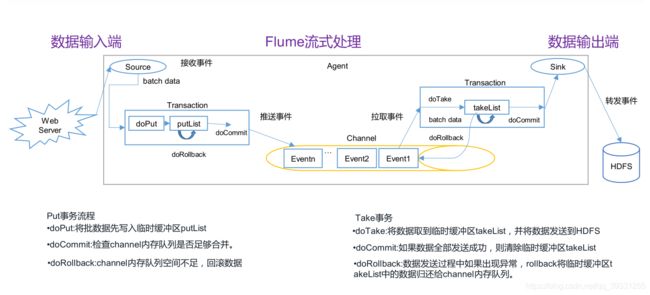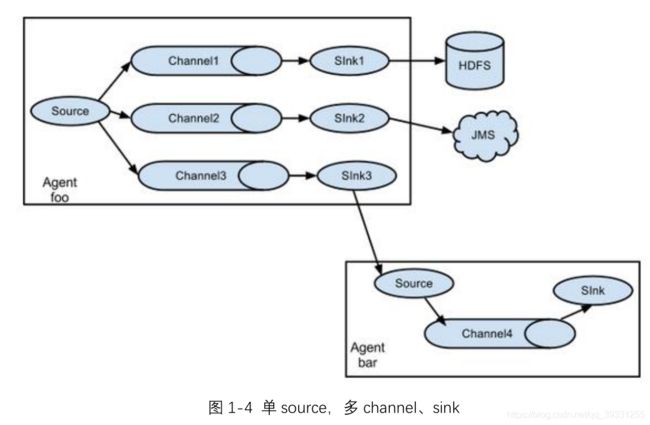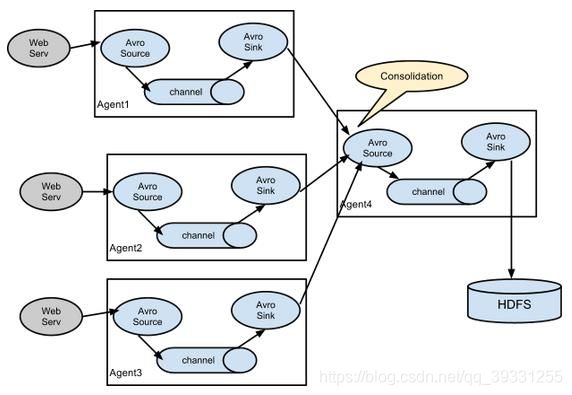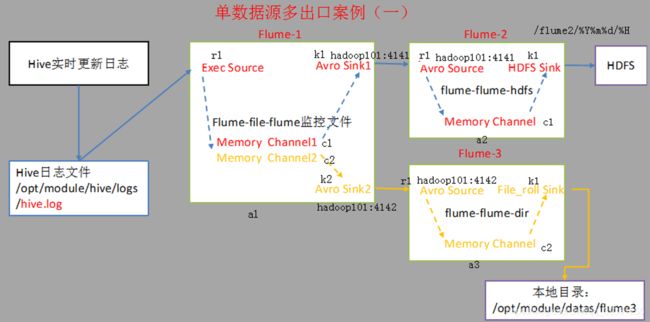flume进阶(事务,原理,自定义,案例)
Flume 事务
Flume Agent 内部原理
Flume 拓扑结构
1.简单串联
2.副本和多路复用(多路复用要配合拦截器使用)
3.负载均衡和故障转移

Flume支持使用将多个sink逻辑上分到一个sink组,sink组配合不同的SinkProcessor可以实现负载均衡和错误恢复的功能。
4.聚合
Flume 企业开发案例
1.副本和多路复用
单数据源多出口案例(副本)
在/opt/module/datas/目录下创建flume3文件夹
[root@hadoop003 datas]$ mkdir flume3
在flume/job目录下创建group1文件夹
[root@hadoop003 job]$ mkdir group1
配置监控日志变化的flume
[root@hadoop003 group1]$ touch flume-file-flume.conf
[root@hadoop003 group1]$ vim flume-file-flume.conf
添加内容
# Name the components on this agent
a1.sources = r1
a1.sinks = k1 k2
a1.channels = c1 c2
# 将数据流复制给多个channel
a1.sources.r1.selector.type = replicating
# Describe/configure the source
a1.sources.r1.type = exec
a1.sources.r1.command = tail -F /opt/module/hive/logs/hive.log
a1.sources.r1.shell = /bin/bash -c
# Describe the sink
a1.sinks.k1.type = avro
a1.sinks.k1.hostname = hadoop003
a1.sinks.k1.port = 4141
a1.sinks.k2.type = avro
a1.sinks.k2.hostname = hadoop003
a1.sinks.k2.port = 4142
# Describe the channel
a1.channels.c1.type = memory
a1.channels.c1.capacity = 1000
a1.channels.c1.transactionCapacity = 100
a1.channels.c2.type = memory
a1.channels.c2.capacity = 1000
a1.channels.c2.transactionCapacity = 100
# Bind the source and sink to the channel
a1.sources.r1.channels = c1 c2
a1.sinks.k1.channel = c1
a1.sinks.k2.channel = c2
配置上级flume输出的source,输出到hdfs
[root@hadoop003 group1]$ touch flume-flume-hdfs.conf
[root@hadoop003 group1]$ vim flume-flume-hdfs.conf
添加内容
# Name the components on this agent
a2.sources = r1
a2.sinks = k1
a2.channels = c1
# Describe/configure the source
a2.sources.r1.type = avro
a2.sources.r1.bind = hadoop003
a2.sources.r1.port = 4141
# Describe the sink
a2.sinks.k1.type = hdfs
a2.sinks.k1.hdfs.path = hdfs://hadoop003:9000/flume2/%Y%m%d/%H
#上传文件的前缀
a2.sinks.k1.hdfs.filePrefix = flume2-
#是否按照时间滚动文件夹
a2.sinks.k1.hdfs.round = true
#多少时间单位创建一个新的文件夹
a2.sinks.k1.hdfs.roundValue = 1
#重新定义时间单位
a2.sinks.k1.hdfs.roundUnit = hour
#是否使用本地时间戳
a2.sinks.k1.hdfs.useLocalTimeStamp = true
#积攒多少个Event才flush到HDFS一次
a2.sinks.k1.hdfs.batchSize = 100
#设置文件类型,可支持压缩
a2.sinks.k1.hdfs.fileType = DataStream
#多久生成一个新的文件
a2.sinks.k1.hdfs.rollInterval = 30
#设置每个文件的滚动大小大概是128M
a2.sinks.k1.hdfs.rollSize = 134217700
#文件的滚动与Event数量无关
a2.sinks.k1.hdfs.rollCount = 0
#最小冗余数
a2.sinks.k1.hdfs.minBlockReplicas = 1
#访问hdfs的超时时间 默认10 000 毫秒
a2.sinks.k1.hdfs.callTimeout = 1000000
# Describe the channel
a2.channels.c1.type = memory
a2.channels.c1.capacity = 1000
a2.channels.c1.transactionCapacity = 100
# Bind the source and sink to the channel
a2.sources.r1.channels = c1
a2.sinks.k1.channel = c1
配置上级flume输出的source,输出到本地目录。
输出的本地目录必须是已经存在的目录。
[root@hadoop003 group1]$ touch flume-flume-dir.conf
[root@hadoop003 group1]$ vim flume-flume-dir.conf
添加内容
# Name the components on this agent
a3.sources = r1
a3.sinks = k1
a3.channels = c2
# Describe/configure the source
a3.sources.r1.type = avro
a3.sources.r1.bind = hadoop003
a3.sources.r1.port = 4142
# Describe the sink
a3.sinks.k1.type = file_roll
a3.sinks.k1.sink.directory = /opt/module/datas/flume3
# Describe the channel
a3.channels.c2.type = memory
a3.channels.c2.capacity = 1000
a3.channels.c2.transactionCapacity = 100
# Bind the source and sink to the channel
a3.sources.r1.channels = c2
a3.sinks.k1.channel = c2
开启hadoop
[root@hadoop003 hadoop-2.7.2]$ sbin/start-dfs.sh
[root@hadoop003 hadoop-2.7.2]$ sbin/start-yarn.sh
开启监控
先开启和关闭流程都是先接收方,后发送方
[root@hadoop003 flume]$ bin/flume-ng agent --conf conf/ --name a3 --conf-file job/group1/flume-flume-dir.conf
[root@hadoop003 flume]$ bin/flume-ng agent --conf conf/ --name a2 --conf-file job/group1/flume-flume-hdfs.conf
[root@hadoop003 flume]$ bin/flume-ng agent --conf conf/ --name a1 --conf-file job/group1/flume-file-flume.conf
开启hive
[root@hadoop003 hive]$ bin/hive
hive (default)>
查看hdfs和本地的数据
2.负载均衡和故障转移
故障转移案例
# Name the components on this agent
a1.sources = r1
a1.sinks = k1 k2
a1.channels = c1
a1.sinkgroups = g1
a1.sources.r1.type = netcat
a1.sources.r1.bind = hadoop003
a1.sources.r1.port = 44444
a1.sinks.k1.type = avro
a1.sinks.k1.hostname = hadoop003
a1.sinks.k1.port = 4545
a1.sinks.k2.type = avro
a1.sinks.k2.hostname = hadoop003
a1.sinks.k2.port = 4546
a1.sinkgroups.g1.sinks = k1 k2
a1.sinkgroups.g1.processor.type = failover
a1.sinkgroups.g1.processor.priority.k1 = 5
a1.sinkgroups.g1.processor.priority.k2 = 10
a1.sinkgroups.g1.processor.maxpenalty = 10000
a1.channels.c1.type = memory
a1.channels.c1.capacity = 1000
a1.channels.c1.transactionCapacity = 100
a1.sources.r1.channels = c1
a1.sinks.k1.channel = c1
a1.sinks.k2.channel = c1
flume-2
# Name the components on this agent
a2.sources = r1
a2.sinks = k1
a2.channels = c1
# Describe/configure the source
a2.sources.r1.type = avro
a2.sources.r1.bind = hadoop003
a2.sources.r1.port = 4545
# Describe the sink
a2.sinks.k1.type = logger
# Use a channel which buffers events in memory
a2.channels.c1.type = memory
a2.channels.c1.capacity = 1000
a2.channels.c1.transactionCapacity = 100
# Bind the source and sink to the channel
a2.sources.r1.channels = c1
a2.sinks.k1.channel = c1
flume-3
# Name the components on this agent
a3.sources = r1
a3.sinks = k1
a3.channels = c1
# Describe/configure the source
a3.sources.r1.type = avro
a3.sources.r1.bind = hadoop003
a3.sources.r1.port = 4546
# Describe the sink
a3.sinks.k1.type = logger
# Use a channel which buffers events in memory
a3.channels.c1.type = memory
a3.channels.c1.capacity = 1000
a3.channels.c1.transactionCapacity = 100
# Bind the source and sink to the channel
a3.sources.r1.channels = c1
a3.sinks.k1.channel = c1
负载均衡
# Name the components on this agent
a1.sources = r1
a1.sinks = k1 k2
a1.channels = c1
a1.sinkgroups = g1
a1.sources.r1.type = netcat
a1.sources.r1.bind = hadoop003
a1.sources.r1.port = 44444
a1.sinks.k1.type = avro
a1.sinks.k1.hostname = hadoop003
a1.sinks.k1.port = 4545
a1.sinks.k2.type = avro
a1.sinks.k2.hostname = hadoop003
a1.sinks.k2.port = 4546
a1.sinkgroups.g1.sinks = k1 k2
a1.sinkgroups.g1.processor.type = load_balance
a1.sinkgroups.g1.processor.backoff = true
a1.sinkgroups.g1.processor.selector = random
a1.channels.c1.type = memory
a1.channels.c1.capacity = 1000
a1.channels.c1.transactionCapacity = 100
a1.sources.r1.channels = c1
a1.sinks.k1.channel = c1
a1.sinks.k2.channel = c1
3.聚合(多数据源汇总案例)
本案例代码实现以三个flume都在hadoop003一台主机上完成,为了方便。
以后可以按下图在三台主机上完成,但都要安装flume
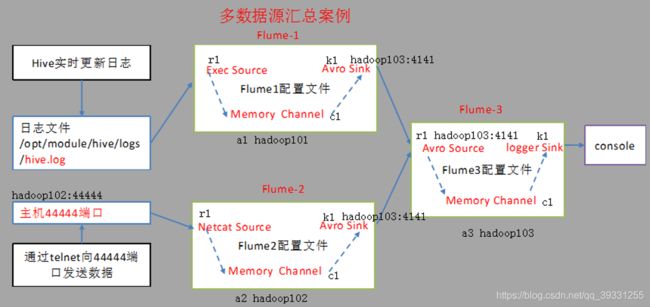
在hadoop003的/opt/module/flume/job目录下创建一个group2文件夹
[root@hadoop003 job]$ mkdir group2
配置flume1监控hive.log,配置sink输出数据到下一级flume3。
[root@hadoop003 group2]$ touch flume-file.conf
[root@hadoop003 group2]$ vim flume1.conf
添加配置内容
# Name the components on this agent
a1.sources = r1
a1.sinks = k1
a1.channels = c1
# Describe/configure the source
a1.sources.r1.type = exec
a1.sources.r1.command = tail -F /opt/module/hive/logs/hive.log
a1.sources.r1.shell = /bin/bash -c
# Describe the sink
a1.sinks.k1.type = avro
a1.sinks.k1.hostname = hadoop003
a1.sinks.k1.port = 4141
# Describe the channel
a1.channels.c1.type = memory
a1.channels.c1.capacity = 1000
a1.channels.c1.transactionCapacity = 100
# Bind the source and sink to the channel
a1.sources.r1.channels = c1
a1.sinks.k1.channel = c1
配置flume2监控端口44444数据流,配置sink数据到下一级flume3:
[root@hadoop003 group2]# vim flume2.conf
添加配置内容
#Name the components on this agent
a2.sources = r1
a2.sinks = k1
a2.channels = c1
# Describe/configure the source
a2.sources.r1.type = netcat
a2.sources.r1.bind = hadoop003
a2.sources.r1.port = 44444
# Describe the sink
a2.sinks.k1.type = avro
a2.sinks.k1.hostname = hadoop003
a2.sinks.k1.port = 4141
# Use a channel which buffers events in memory
a2.channels.c1.type = memory
a2.channels.c1.capacity = 1000
a2.channels.c1.transactionCapacity = 100
# Bind the source and sink to the channel
a2.sources.r1.channels = c1
a2.sinks.k1.channel = c1
配置flume3用于接收flume1与flume2发送过来的数据流,最终合并后sink到控制台。
[root@hadoop003 group2]# vim flume3.conf
添加配置内容
#Name the components on this agent
a3.sources = r1
a3.sinks = k1
a3.channels = c1
# Describe/configure the source
a3.sources.r1.type = avro
a3.sources.r1.bind = hadoop003
a3.sources.r1.port = 4141
# Describe the sink
# Describe the sink
a3.sinks.k1.type = logger
# Describe the channel
a3.channels.c1.type = memory
a3.channels.c1.capacity = 1000
a3.channels.c1.transactionCapacity = 100
# Bind the source and sink to the channel
a3.sources.r1.channels = c1
a3.sinks.k1.channel = c1
分别开启对应配置文件:flume3.conf,flume2.conf,flume1.conf。
开启flume3
bin/flume-ng agent --conf conf/ --name a3 --conf-file job/group2/flume3.conf -Dflume.root.logger=INFO,console
开启flume2
bin/flume-ng agent --conf conf/ --name a2 --conf-file job/group2/flume2.conf
登录到hadoop003向44444端口发送数据asd

查看flume3的监控
开启flume1
bin/flume-ng agent --conf conf/ --name a1 --conf-file job/group2/flume1.conf
[root@hadoop003 logs]# echo ‘111111’ >> hive.log
查看flume3的监控
4.自定义拦截器interceptor(多路复用)
Interceptor和Multiplexing ChannelSelector结合使用
实现:为每一个evnet加上header(kv对),在编写flume的conf文件中,在ChannelSelector位置让每个v分发到不同的channel
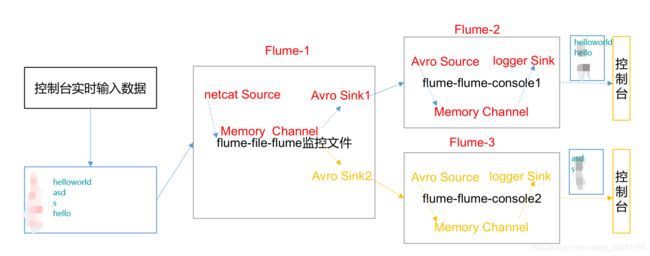
编写拦截器类,然后打jar包上传到虚拟机的flume/lib下
导入依赖
<dependencies>
<dependency>
<groupId>org.apache.flume</groupId>
<artifactId>flume-ng-core</artifactId>
<version>1.7.0</version>
</dependency>
</dependencies>
编写类
package com.demo;
import org.apache.flume.Context;
import org.apache.flume.Event;
import org.apache.flume.interceptor.Interceptor;
import java.util.ArrayList;
import java.util.List;
import java.util.Map;
/**
* @author ljh
* @create 2021-02-20 18:20
*/
public class TypeInterceptor implements Interceptor {
//创建存放事件的集合
List<Event> typeEvents;
//初始化集合
public void initialize() {
typeEvents=new ArrayList<Event>();
}
//单个事件拦截
public Event intercept(Event event) {
//获取事件的头信息和body信息
Map<String, String> headers = event.getHeaders();
String body = new String(event.getBody());
//根据body中数据是否包含hello来决定添加怎样的头信息
if(body.contains("hello")){
headers.put("type","good");
}else{
headers.put("type","bad");
}
return event;
}
//批量事件拦截
public List<Event> intercept(List<Event> list) {
//清空集合中上次传来的event
typeEvents.clear();
//给每一个event添加头信息
for (Event event:list){
Event e = intercept(event);
typeEvents.add(e);
}
return typeEvents;
}
public void close() {
}
//类名随便起,使用时要写这个类名
public static class Builder implements Interceptor.Builder{
public Interceptor build() {
return new TypeInterceptor();
}
public void configure(Context context) {
}
}
}
a1采集数据,多路复用传给a2,a3
此处的type值是根据自定义类的全类名+内部类的类名

# Name the components on this agent
a1.sources = r1
a1.sinks = k1 k2
a1.channels = c1 c2
# Describe/configure the source
a1.sources.r1.type = netcat
a1.sources.r1.bind = localhost
a1.sources.r1.port = 44444
a1.sources.r1.interceptors = i1
a1.sources.r1.interceptors.i1.type =com.demo.TypeInterceptor$Builder
a1.sources.r1.selector.type = multiplexing
a1.sources.r1.selector.header = type
a1.sources.r1.selector.mapping.good = c1
a1.sources.r1.selector.mapping.bad = c2
# Describe the sink
a1.sinks.k1.type = avro
a1.sinks.k1.hostname = hadoop003
a1.sinks.k1.port = 4545
a1.sinks.k2.type = avro
a1.sinks.k2.hostname = hadoop003
a1.sinks.k2.port = 4546
# Use a channel which buffers events in memory
a1.channels.c1.type = memory
a1.channels.c1.capacity = 1000
a1.channels.c1.transactionCapacity = 100
a1.channels.c2.type = memory
a1.channels.c2.capacity = 1000
a1.channels.c2.transactionCapacity = 100
# Bind the source and sink to the channel
a1.sources.r1.channels = c1 c2
a1.sinks.k1.channel = c1
a1.sinks.k2.channel = c2
a2打印到控制台(包含hello的)
a2.sources = r1
a2.sinks = k1
a2.channels = c1
a2.sources.r1.type = avro
a2.sources.r1.bind = hadoop003
a2.sources.r1.port = 4545
a2.sinks.k1.type = logger
a2.channels.c1.type = memory
a2.channels.c1.capacity = 1000
a2.channels.c1.transactionCapacity = 100
a2.sources.r1.channels = c1
a2.sinks.k1.channel = c1
a3打印到控制台(不包含hello的)
a3.sources = r1
a3.sinks = k1
a3.channels = c1
a3.sources.r1.type = avro
a3.sources.r1.bind = hadoop003
a3.sources.r1.port = 4546
a3.sinks.k1.type = logger
a3.channels.c1.type = memory
a3.channels.c1.capacity = 1000
a3.channels.c1.transactionCapacity = 100
a3.sources.r1.channels = c1
a3.sinks.k1.channel = c1
执行
flume-ng agent -n a1 -c /opt/module/flume-1.7.0/conf/ -f netcat-intercepter-avros.conf
flume-ng agent -n a2 -c /opt/module/flume-1.7.0/conf/ -f avro-flume-logs1.conf -Dflume.root.logger=INFO,console
flume-ng agent -n a3 -c /opt/module/flume-1.7.0/conf/ -f avro-flume-logs2.conf -Dflume.root.logger=INFO,console
5.自定义source
开发者文档http://flume.apache.org/releases/content/1.7.0/FlumeDeveloperGuide.html#source

实现:导入依赖,编写自定义source代码,打jar包放入flume/lib下,编写conf,在source部分引入自定义source全类名,就可以运行了。
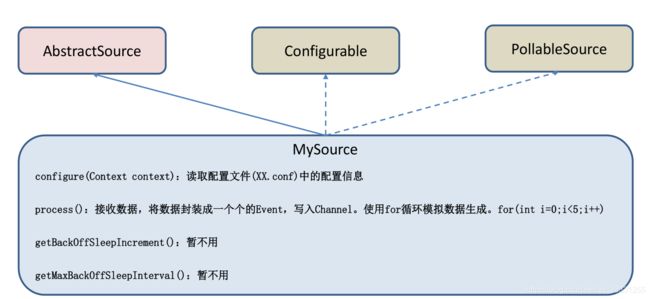
需求:使用 flume 接收数据,并给每条数据添加前缀,输出到控制台。前缀可从 flume 配置文件中配置。
导入依赖
<dependencies>
<dependency>
<groupId>org.apache.flume</groupId>
<artifactId>flume-ng-core</artifactId>
<version>1.7.0</version>
</dependency>
</dependencies>
编写类
package com.demo;
import org.apache.flume.Context;
import org.apache.flume.Event;
import org.apache.flume.EventDeliveryException;
import org.apache.flume.PollableSource;
import org.apache.flume.conf.Configurable;
import org.apache.flume.event.SimpleEvent;
import org.apache.flume.source.AbstractSource;
/**
* @author ljh
* @create 2021-02-22 16:34
*/
public class MySource extends AbstractSource implements Configurable, PollableSource {
private String prefix;
private String subfix;
//读取配置信息,给前后缀赋值
public void configure(Context context) {
prefix=context.getString("prefix");//读配置赋值
subfix=context.getString("subfix","aaa");//给默认值(如果配置文件里赋值,先用配置文件的)
}
/**
* 接收数据(此处我们用for循环造数据,以后可以通过io流和jdbc接受数据)
* 将数据封装到event中
* 把event传给channel
* @return
*
*/
public Status process() throws EventDeliveryException {
Status status=null;
try {
for (int i=0;i<5;i++){
//构建事件
SimpleEvent event = new SimpleEvent();//此行不能提到循环外,本来想提出去减少创建event对象,没想到不行
//给event传入数据
//前缀设置值,后缀用默认值
event.setBody((prefix+"--"+i+"--"+subfix).getBytes());
//将evnet传递给channel
getChannelProcessor().processEvent(event);
status=Status.READY;
}
} catch (Exception e) {
e.printStackTrace();
status=Status.BACKOFF;
}
//接受一次睡2s,免得发送太快不便于观察
try {
Thread.sleep(2000);
} catch (InterruptedException e) {
e.printStackTrace();
}
return status;
}
public long getBackOffSleepIncrement() {
return 0;
}
public long getMaxBackOffSleepInterval() {
return 0;
}
}
配置文件
a1.sources = r1
a1.sinks = k1
a1.channels = c1
# Describe/configure the source
a1.sources.r1.type = com.demo.MySource
a1.sources.r1.prefix = hello
a1.sources.r1.subfix = ss
# Describe the sink
a1.sinks.k1.type = logger
# Use a channel which buffers events in memory
a1.channels.c1.type = memory
a1.channels.c1.capacity = 1000
a1.channels.c1.transactionCapacity = 100
# Bind the source and sink to the channel
a1.sources.r1.channels = c1
a1.sinks.k1.channel = c1
执行
flume-ng agent -n a1 -c /opt/module/flume-1.7.0/conf/ -f mySource.conf -Dflume.root.logger=INFO,console
提示:loggersink每条日志的输出长度是有默认值的 官网:maxBytesToLog 16 Maximum number of bytes of the Event body to log
6.自定义 Sink
Sink 是完全事务性的。在从 Channel 批量删除数据之前,每个 Sink 用 Channel 启动一个事务。批量事件一旦成功写出到存储系统或下一个 Flume Agent,Sink 就利用 Channel 提交事务。事务一旦被提交,该 Channel 从自己的内部缓冲区删除事件。
需求:使用 flume 接收数据,并在 Sink 端给每条数据添加前缀和后缀,输出到控制台。前后缀可在 flume 任务配置文件中配置。
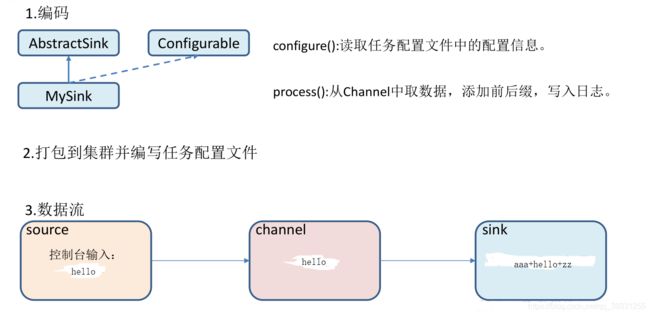
自定义类,打jar包上传
package com.demo;
import org.apache.flume.*;
import org.apache.flume.conf.Configurable;
import org.apache.flume.sink.AbstractSink;
import org.slf4j.Logger;
import org.slf4j.LoggerFactory;
/**
* @author ljh
* @create 2021-02-22 21:04
*/
public class MySink extends AbstractSink implements Configurable {
//定义前后缀,来测试一下通过conf配置文件的kv赋值
private String prefix;
private String subfix;
//创建logger对象
private Logger logger = LoggerFactory.getLogger(MySink.class);
public void configure(Context context) {
prefix = context.getString("prefix");//从conf获取值
subfix=context.getString("subfix");//给默认值
}
/**
*获取channel
* 从channel获取事务和event
* 发送event
*/
public Status process() throws EventDeliveryException {
Status status= null;
Channel channel = getChannel();
Transaction transaction = channel.getTransaction();
try {
transaction.begin();
Event event = channel.take();
//处理event
if(event!=null){
String body = new String(event.getBody());
//以logger形式输出,至于输出到控制台还是文件,要靠配置信息-Dflume.root.logger=INFO,console
String tmp=prefix + body+subfix;//此处有问题,不出后缀,目前找不出问题所在
logger.info(tmp);
}
transaction.commit();
status=Status.READY;
} catch (ChannelException e) {
e.printStackTrace();
transaction.rollback();
status=Status.BACKOFF;
}finally {
transaction.close();
}
return status;
}
}
编写conf
# Name the components on this agent
a1.sources = r1
a1.sinks = k1
a1.channels = c1
# Describe/configure the source
a1.sources.r1.type = netcat
a1.sources.r1.bind = localhost
a1.sources.r1.port = 44444
# Describe the sink
a1.sinks.k1.type = com.demo.MySink
a1.sinks.k1.prefix=aaa
a1.sinks.k1.subfix=qq
# Use a channel which buffers events in memory
a1.channels.c1.type = memory
a1.channels.c1.capacity = 1000
a1.channels.c1.transactionCapacity = 100
# Bind the source and sink to the channel
a1.sources.r1.channels = c1
a1.sinks.k1.channel = c1
启动agent
flume-ng agent -n a1 -c /opt/module/flume-1.7.0/conf/ -f mySink.conf -Dflume.root.logger=INFO,console
